RESEARCH
Supplementary polio immunization activities and prior use of routine immunization services in non-polio-endemic sub-Saharan Africa
Campagnes de vaccination antipoliomyélitique supplémentaire et recours antérieur aux services de vaccination de routine en Afrique subsaharienne non-polio-endémique
Actividades suplementarias de inmunización contra la poliomielitis y uso previo de servicios de inmunización sistemática en los países del África subsahariana donde la enfermedad no es endémica
Stephane HelleringerI*; Jemima A FrimpongI; Jalaa AbdelwahabII; Patrick AsumingIII; Hamadassalia TouréII; John Koku Awoonor-WilliamsIV; Thomas AbachieIV; Flavia GuidettiII
IHeilbrunn Department of Population and Family Health, Columbia University, 60 Haven Avenue B-2, New York, NY 10032, United States of America (USA)
IIUnited Nations Children's Fund, New York, USA
IIIDepartment of Economics, Columbia University, New York, USA
IVGhana Health Service, Accra, Ghana
ABSTRACT
OBJECTIVE: To determine participation in polio supplementary immunization activities (SIAs) in sub-Saharan Africa among users and non-users of routine immunization services and among users who were compliant or non-compliant with the routine oral poliovirus vaccine (OPV) immunization schedule.
METHODS: Data were obtained from household-based surveys in non-polio-endemic sub-Saharan African countries. Routine immunization service users were children (aged < 5 years) who had ever had a health card containing their vaccination history; non-users were children who had never had a health card. Users were considered compliant with the OPV routine immunization schedule if, by the SIA date, their health card reflected receipt of required OPV doses. Logistic regression measured associations between SIA participation and use of both routine immunization services and compliance with routine OPV among users.
FINDINGS: Data from 21 SIAs conducted between 1999 and 2010 in 15 different countries met inclusion criteria. Overall SIA participation ranged from 70.2% to 96.1%. It was consistently lower among infants than among children aged 1-4 years. In adjusted analyses, participation among routine immunization services users was > 85% in 12 SIAs but non-user participation was > 85% in only 5 SIAs. In 18 SIAs, participation was greater among users (P < 0.01 in 16, 0.05 in 1 and < 0.10 in 1) than non-users. In 14 SIAs, adjusted analyses revealed lower participation among non-compliant users than among compliant users (P < 0.01 in 10, < 0.05 in 2 and < 0.10 in 2).
CONCLUSION: Large percentages of children participated in SIAs. Prior use of routine immunization services and compliance with the routine OPV schedule showed a strong positive association with SIA participation.
RÉSUMÉ
OBJECTIF: Déterminer la participation aux campagnes de supplémentation vaccinale en Afrique subsaharienne parmi les utilisateurs et les non-utilisateurs des services de vaccination de routine et parmi les utilisateurs conformes ou non-conformes au protocole de vaccination antipoliomyélitique orale.
MÉTHODES: Les données ont été obtenues à partir d'enquêtes de ménages conduites dans des pays non-polio-endémiques d'Afrique subsaharienne. Les utilisateurs des services de vaccination de routine étaient des enfants (âgés de moins de 5 ans) ayant possédé un jour un carnet de santé contenant leur historique vaccinal; les non-utilisateurs étaient des enfants n'ayant jamais possédé de carnet de santé. Les utilisateurs ont été considérés comme conformes au protocole de vaccination antipoliomyélitique orale si, à la date de la campagne, leur carnet de santé reflétait l'administration des doses de vaccination antipoliomyélitique orale requises. Une régression logistique a mesuré les associations entre la participation à la campagne et tant le recours aux services de vaccination de routine que la conformité au protocole de vaccination antipoliomyélitique orale des utilisateurs.
RÉSULTATS: Les données provenant de 21 campagnes de supplémentation vaccinale menées entre 1999 et 2010 dans 14 pays différents ont satisfait les des critères d'inclusion. La participation globale aux campagnes variait de 70,2% à 96,1%. Elle était toujours plus faible chez les nourrissons que chez les enfants âgés de 1 à 4 ans. Dans les analyses ajustées, la participation parmi les utilisateurs des services de vaccination de routine était >85% dans 12 campagnes, mais la participation des non-utilisateurs était >85% pour seulement 5 campagnes. Dans 18 campagnes, la participation était plus élevée chez les utilisateurs (P <0,01 pour 16, <0,05 pour 1 et <0,10 pour 1) que chez les non-utilisateurs. Dans 14 campagnes, les analyses ajustées ont révélé une plus faible participation chez les utilisateurs non-conformes que chez les utilisateurs conformes (P <0,01 pour 10, <0,05 pour 2 et <0,10 pour 2).
CONCLUSION: Un pourcentage élevé d'enfants ont participé à des campagnes. Le recours antérieur aux services de vaccination de routine et la conformité au protocole de vaccination orale ont montré une forte corrélation positive avec la participation aux campagnes.
RESUMEN
OBJETIVO: Determinar la participación en las actividades suplementarias de inmunización (ASI) contra la poliomielitis en el África subsahariana entre los usuarios y no usuarios de los servicios de inmunización sistemática, así como entre los usuarios que se atuvieron o no al calendario de vacunación antipoliomielítica oral (OPV).
MÉTODOS:Los datos se obtuvieron a través de encuestas de hogares en países del África subsahariana en los que la poliomielitis no es endémica. Los usuarios del servicio de inmunización sistemática fueron niños (con edades inferiores a cinco años) que disponían de una tarjeta sanitaria con sus antecedentes de vacunación; los no usuarios fueron niños que nunca habían tenido una tarjeta sanitaria. Se consideró que los usuarios cumplían con el calendario de vacunación OPV si, al iniciar la campaña, sus tarjetas sanitarias reflejaban que habían recibido las dosis OPV obligatorias. La regresión logística midió las relaciones existentes entre la participación en las ASI, el uso de ambos servicios de inmunización sistemática y la conformidad con la OPV sistemática entre los usuarios.
RESULTADOS: Los datos de 21 ASI realizadas entre 1999 y 2010 en 15 países diferentes reunieron los criterios de inclusión. De manera global, la participación en las ASI fue de entre el 70,2% y el 96,1%, y fue sistemáticamente menor entre lactantes que entre niños con edades comprendidas entre uno y cuatro años. En los análisis ajustados, la participación entre los usuarios de los servicios de inmunización sistemática fue superior al 85% en 12 ASI, mientras que la participación de no usuarios fue superior al 85% en solo cinco ASI. En 18 de las actividades suplementarias de inmunización, la participación fue mayor entre usuarios (P < 0,01 en 16 de ellas, 0,05 en una y < 0,10 en una) que entre no usuarios. En 14 de las ASI, los análisis ajustados revelaron una participación menor entre usuarios que no se ajustaban al calendario de vacunación que entre aquellos que sí lo hacían (P < 0,01 en 10, < 0,05 en 2 y < 0,10 en 2).
CONCLUSIÓN: Un porcentaje amplio de niños participaron en las actividades suplementarias de inmunización. El uso previo de servicios de inmunización sistemática y la conformidad con el calendario de OPV mostraron una relación positiva muy fuerte con la participación en las ASI.
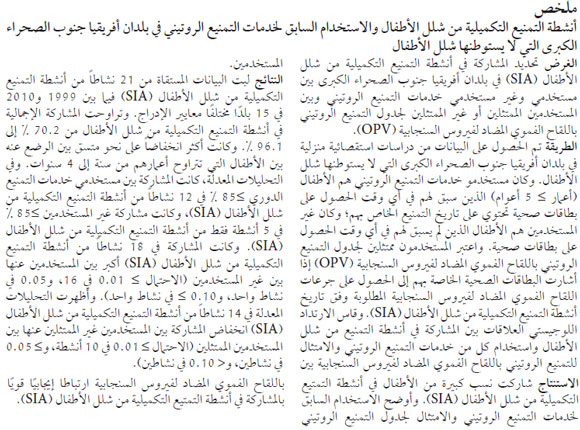
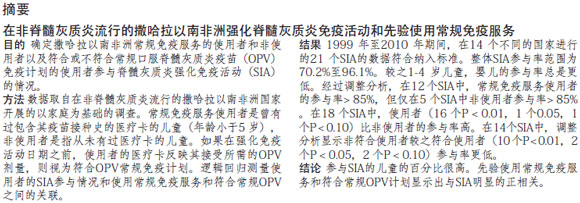

Introduction
Since the late 1980s, use of supplementary immunization activities (SIAs) has been a key strategy of the Global Polio Eradication Initiative (GPEI). SIAs are mass vaccination campaigns that aim to administer additional doses of oral poliovirus vaccine (OPV) to each child aged < 5 years, regardless of their vaccination history. In doing so, SIAs attempt to remedy the limited ability of routine immunization services to reach at-risk children with the number of OPV doses required to generate immunity.1,2 In many countries, SIAs have largely contributed to the 99% global reduction in the incidence of paralytic poliomyelitis observed since the 1988 launch of the GPEI.2-4
Despite the central role of SIAs in eradication efforts, setbacks in the GPEI have been attributed to low-quality SIAs.5 Target dates for eradication have repeatedly been pushed back and, at present, transmission of wild poliovirus remains endemic in Afghanistan, Nigeria and Pakistan. Four countries where circulation of wild poliovirus had stopped (Angola, Chad, Democratic Republic of the Congo and South Sudan) have been labelled as having "re-established polio transmission" and several other countries previously considered to be "polio free" have reported cases of acute flaccid paralysis due to wild poliovirus strains originating from northern Nigeria.6,7 A wild poliovirus "importation belt" thus stretches from Senegal to the Horn of Africa. To achieve eradication, the 2010-2012 GPEI strategic plan sets strict targets of > 90% coverage for each SIA conducted in the importation belt. Even in such highly immunized populations, however, outbreaks may still occur if much lower coverage is achieved for particular subpopulations.8 In particular, the influence of SIAs on population-level immunity against polio may be lowered if children who do not access routine immunization services (and are thus less likely to be immune to polio and other vaccine-preventable diseases) also participate less frequently in SIAs.
Very limited data on patterns of SIA participation are available that consider past use of routine immunization services. In a study of the 1997 Madagascar SIA, Andrianarivelo and colleagues9 reported significantly increased SIA-associated immunity among children who had not used routine immunization services or had missed routine OPV doses. Currently collected data on SIA coverage do not include an assessment of the immunization history of children who were not vaccinated during SIAs. The effectiveness of polio SIAs at supplementing routine immunization services in non-polio-endemic sub-Saharan African countries is thus not known. In this article, we test the hypothesis that children who did not use routine immunization services before an SIA were less likely to participate in that SIA, compared with children who were users of routine services. We also measured SIA participation among users of routine immunization services who were compliant with the routine OPV immunization schedule, compared with users who were non-compliant.
Methods
Data collection and study groups
We used three data sources: Demographic and Health Surveys (DHSs), Multiple Indicator Cluster Surveys (MICSs) and the 2010 Mobile Technology for Community Health (MoTeCH) survey (Appendix A, available at: http://www.columbia.edu/~sh2813/appendix-02292012sh.pdf ). The first two sources are nationally representative household-based surveys conducted, on average, every 3-6 years in several sub-Saharan countries. The MoTeCH survey is a household-based survey conducted among women residing in the Kassena-Nankana East and West districts in Ghana's Upper East Region. In all surveys, data on participation in SIAs and use of routine immunization services were collected in a similar manner. Mothers were asked to provide vaccination information for their surviving children < 5 years old.10-12 They were first asked whether their child had ever had a health card. Health cards are small booklets, usually given to mothers or guardians at the time of delivery or during the first vaccination visit, in which health workers record receipt of various antigens recommended through the World Health Organization's (WHO's) Expanded Programme on Immunization. For children whose health card was available at the time of the survey, interviewers transcribed the date of each vaccination recorded in the card. Interviewers then asked mothers to specify types of undocumented vaccination, if any, these children received. For children whose health card was not available at the time of the survey or who had never had a health card, interviewers asked mothers to specify every vaccination these children received but vaccination dates were not requested.
Because vaccinations received during polio SIAs are not recorded in children's health cards by health workers and volunteers, OPV doses documented in health cards represent doses obtained through routine immunization services. We thus used health-card data to measure children's prior use of routine immunization services in two ways. First, we used ownership of a health card to distinguish children who had ever used routine immunization services (hereafter, "users") from children who had never used routine immunization services (hereafter "non-users"). Second, among users, we distinguished children who were compliant with routine OPV immunization from children who were not compliant by examining the age at which each OPV dose was received. Most countries in sub-Saharan Africa use a standard schedule for OPV: the first OPV dose is administered at 6 weeks of age; the second, at 10 weeks; and the third, at 14 weeks. Thus, we classified children as compliant if, at the time of the SIA, their health card reflected receipt of each required OPV dose. For example, a child who was 20 weeks old at the time of an SIA and had the third OPV dose documented in their health card would be classified as compliant, whereas a child who was 11 weeks old at the time of an SIA and had only the first OPV dose documented in their health card would be classified as non-compliant.
In many of the MICSs and DHSs and in the MoTeCH survey, mothers are asked about their children's participation in recent polio SIAs. In some surveys, mothers are asked only whether their children participated in any SIA in recent years. In other surveys, mothers are asked whether their children participated in a specific SIA. Surveys were included in this study only if they included assessment of participation in a specific SIA for which the date of implementation was available. We obtained dates of SIAs directly from the survey questionnaire or indirectly from the WHO calendar of SIAs (available at: http://apps.who.int/immunization_monitoring/en/globalsummary/siacalendar/padvancedsia.cfm ) To limit recall bias, we further excluded SIA data if collection of survey data began > 12 months after an SIA. We also excluded subnational SIAs because it was impossible to determine which of the children included in survey data sets were targeted.
Data analysis
All analyses excluded children whose day of birth was unavailable or who were born after the SIA of interest was held. Analyses of SIA participation among compliant and non-compliant users excluded children whose health card was not reviewed by the interviewer, was incomplete or had an invalid sequence of receipt dates for routine OPV doses (e.g. the date of the second dose was more recent than the date of the third dose).
Primary analyses used logistic regression models to measure the associations between SIA participation and prior routine immunization use and between SIA participation and routine immunization compliance. Such models included SIA participation as the (dichotomous) dependent variable and controlled for child age and sex, mother age and education level and household characteristics (i.e. religion and ethnicity of the household head, wealth quintile and urban/rural residence). We also included a set of regional fixed effects. Standard errors were adjusted for the clustering of observations within enumeration areas and households. We report adjusted frequencies of SIA participation derived from the logistic regression models, by routine immunization service use and routine OPV immunization compliance. These frequencies were computed using the margin command in Stata, version 12 (StataCorp, College Station, United States of America), after setting other covariates at their mean value.
We conducted two robustness tests of the logistic regression models used in our primary analyses. The first test re-estimated the models after inclusion of all children for whom the month but not day of birth was available. In this test, only children who were aged > 4 months at the time of the SIA and, thus, were supposed to have completed the routine OPV schedule were included. The second test re-estimated the models after reclassification of children who first used routine immunization services after the SIA of interest as non-users.
In a secondary investigation, we compared the organizational attributes, human resources and budgetary allocations for three SIAs conducted in Benin, to explore why some SIAs are more successful than others at reaching undervaccinated children. Benin was selected for this investigation because (i) it is the only country for which we had survey data on participation in 3 SIAs, (ii) SIA implementation records were available to the study team and (iii) SIA participation among non-users of routine services during SIAs in 2005 and 2006 was significantly less than that during an SIA in 2000 (61-64% in 2005-2006 versus 91% in 2000, see below).
Results
Characteristics of SIAs and children
We reviewed data from 119 surveys conducted between 1988 and 2010. Data from 21 SIAs (Fig. 1) met inclusion criteria. These primarily included SIAs conducted in the wild poliovirus importation belt, as well as one in Lesotho and two in Namibia. One SIA was conducted in 1999, three in 2000, four in 2004, nine in 2005, three in 2006 and one in 2010.
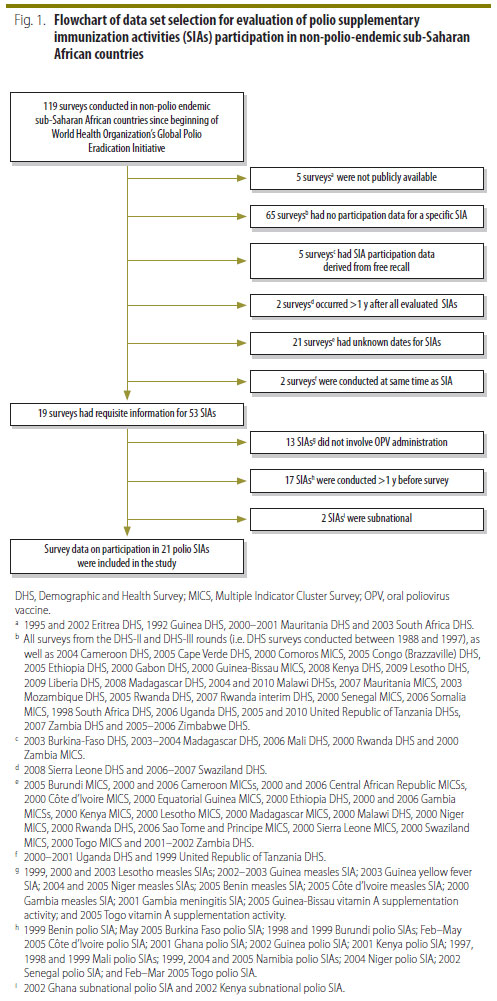
The proportion of children with a known date of birth varied greatly across countries (Table 1). Among children with a known birthday, between 74.5% (during the 2000 Benin SIA) and 93.6% (during the 2004 Lesotho SIA) were alive at the time of the SIA. Between 94.3% and 99.8% of respondents answered the specific SIA questions. Prior use of routine immunization services varied significantly across countries: during the 2004 Lesotho SIA, only 1.3% of sampled children were non-users of routine immunization services, whereas during the 2000 Mali SIA, non-users comprised 29.2% of children.
SIA participation
Full results of logistic regression analyses of the probability of SIA participation are reported in Appendix B (available at: http://www.columbia.edu/~sh2813/appendix-02292012sh.pdf ). SIA participation ranged from 70.2% (during the 2004 Lesotho SIA) to 96.1% (during the 1999 Burundi SIA). In most SIAs, participation was lower among infants than among children 1-4 years old. SIA participation increased with age and educational level of the mother or guardian. In 8 of 17 SIAs for which data on household wealth were available, SIA participation was highest among wealthier households. In 7 SIAs, participation was associated with residential location: 2 SIAs (the 1999 Burundi SIA and the 2005 Sierra Leone SIA) had greater participation in rural areas and 5 SIAs (the 2000 Mali SIA, the 2000 Benin SIA, the 2005 Burkina-Faso SIA, the 2005 Gambia SIA and the 2006 Namibia SIA) had greater participation in urban areas. There were regional differences in participation in all SIAs but differences associated with ethnicity were less common. Religious differences in SIA participation were observed in 6 SIAs, during which participation was lower among people with traditionalist beliefs than among Christians and Muslims.
Prior use of routine services
In adjusted logistic regression analyses (Fig. 2), user participation was > 85% for 12 SIAs but non-user participation was > 85% in only 5 SIAs. In 18 of 21 SIAs, participation was significantly higher (P < 0.01 in 16 SIAs, P < 0.05 in 2 SIAs and P < 0.1 in 1 SIA), among routine immunization service users ( Fig. 2 ). In robustness analyses, however (Appendix C and Appendix D, both available at: http://www.columbia.edu/~sh2813/appendix-02292012sh.pdf), participation was higher among routine immunization service users than among non-users in all but 1 SIA, which occurred during 2000 in Benin, discussed below. These differences in SIA participation by prior use of routine immunization services were sometimes very large. For example, during the 2010 Ghana SIA in the Kassena-Nankana districts, adjusted SIA participation was 91.5% among routine immunization service users but only 32.7% among non-users (P < 0.01).
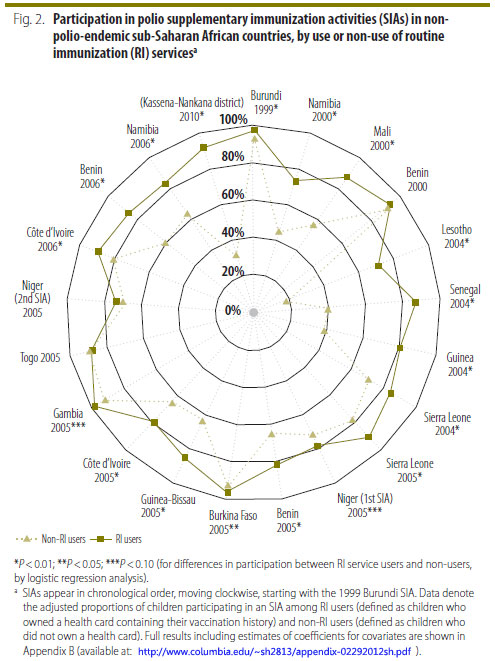
OPV compliance among users
Among routine immunization service users, the proportion of compliant children varied significantly across countries (Appendix E, available at: http://www.columbia.edu/~sh2813/appendix-02292012sh.pdf ). Fewer than 60% of users had received all required routine OPV doses for their age before the 1999 Burundi SIA, the 2000 Mali SIA, the 2004 and 2005 Sierra Leone SIAs and both 2005 Niger SIAs. On the other hand, > 80% of users were compliant with the routine vaccination schedule before the 2004 Lesotho SIA and the 2006 Namibia SIA (Appendix E). SIA participation among compliant users was significantly higher than that among non-compliant ones in 14 of 21 SIAs analysed (Fig. 3). The largest difference was observed during the 2004 Guinea SIA, in which 68.8% of non-compliant routine immunization users participated, compared with 85.4% of compliant users (P < 0.01).
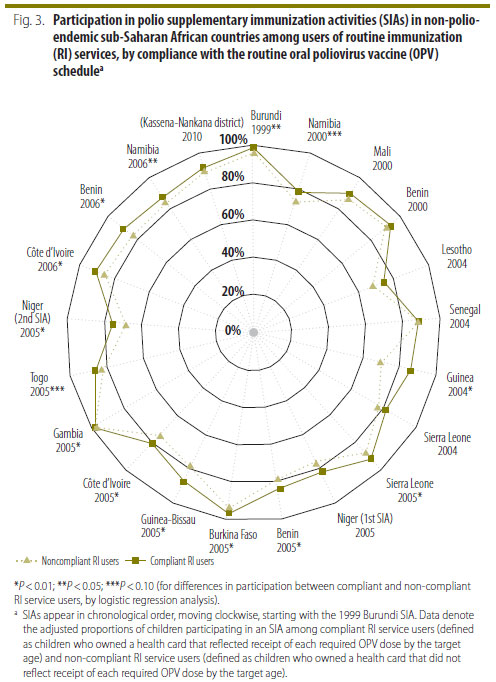
The Benin case study
Although participation in the 2000 Benin SIA was high (> 90%) among both routine immunization service users and non-users, SIAs conducted in 2005 and 2006 had high participation among users but much lower participation among non-users (approximately 60%; Fig. 2). Investigation of the SIAs' budgetary allocations revealed that the percentage of the budget allocated to community mobilization declined sharply, from 19.8% in 2000 to 10.1% in 2005 and 11.1% in 2006 (Table 2).
Discussion
In this study, we used data from the MICS, the DHS and a recent survey we conducted in two districts of Ghana's Upper East Region to document patterns of participation in polio SIAs in sub-Saharan African countries where polio is not endemic. We found that a large percentage of undervaccinated children benefit from vaccination opportunities offered during SIAs every year but that SIAs only imperfectly remedy the limited reach of routine immunization services. In the 21 SIAs we analysed, reported SIA participation among routine immunization users was often significantly higher than that among non-users. Compliant users were also often more likely than non-compliant users to participate in SIAs, but these differences were of much smaller magnitude than those between users and non-users. Of 3 SIAs in Benin, the one with the highest participation among non-users had the greatest percentage of the total SIA budget invested in community mobilization.14 During the 2010 Ghana SIA, some of the possible reasons for low SIA participation among non-users of routine immunization services included inappropriate marking of houses in the targeted areas, incomplete training of volunteers, lack of local maps of the targeted areas among teams and suboptimal supervision.15
Our study has several potential limitations. First, analyses were limited to 21 of thousands of SIAs conducted since the launch of the GPEI and excluded SIAs conducted in countries where polio transmission is endemic or considered to be re-established. Also, most data were for SIAs conducted before 2006. Although analyses of the 2010 Ghana SIA suggest that large differences in SIA participation between routine immunization service users and non-users may have persisted in recent years, data from the MoTeCH survey are not nationally representative and are derived from a limited sample size. Second, data were limited to children for whom a valid birth date was reported and were thus possibly affected by sample selection bias. However, robustness analyses involving children for whom the month but not day of birth was known (Appendix C) yielded results very similar to those for children whose birth date was known ( Fig. 1 and Fig. 2 ). Third, SIA participation was determined on the basis of maternal recall and self-report rather than on the basis of more objective methods (e.g. finger marking5 ). Although we attempted to minimize recall bias by excluding SIA data if the associated survey was conducted > 12 months after the SIA, a desire to state socially acceptable responses to survey questions might have tempted some mothers to exaggerate the extent to which their children participated in SIAs. Fourth, the criterion used to distinguish routine immunization users from non-users is a potential source of information bias. If SIAs stimulate interest in immunization among undervaccinated children, non-users who participate in an SIA might subsequently begin accessing routine immunization services, which could result in their misclassification as routine immunization service users at the time of the SIA. The results in Appendix D, however, indicate that this source of bias is unlikely to have explained the observed patterns. Fifth, our data have limitations common to retrospective studies of vaccination status (e.g. they exclude children who died or moved before the survey).16 Finally, our exploration of the factors that may explain low SIA coverage among non-users of routine immunization services was limited. It was based solely on the comparison of three SIAs conducted in one country (Benin); used only data from SIA budgets and planning documents, rather than data tracking the implementation of SIAs at the local (i.e. district) level17 ; and did not incorporate elements (e.g. rumours and fatigue) characterizing the demand for SIAs and immunization among local populations.
Our study nonetheless has important implications for polio eradication. First, our findings provide insights into factors explaining the recurrent importation of wild poliovirus in previously polio-free sub-Saharan countries since 2002. Specifically, differences in SIA coverage between routine immunization service users and non-users may have maintained local pockets of susceptibility to polio importation. Second, our analyses suggest that SIA monitoring in the GPEI should include an assessment of the vaccination history of children "missed" by vaccination teams during SIAs. Current monitoring practices do not include such assessment and thus do not permit identification of possible pockets of individuals susceptible to infection. Whereas the 2010 Ghana SIA met the GPEI's quality criterion of > 90% participation in the two Kassena-Nankana districts, we found very low coverage among non-users of routine immunization services, who are most likely to be undervaccinated. Finally, our analyses have implications for strategies to improve SIA quality in the GPEI. At present, quality assessments are focused on estimating the proportion of children who were not reached during an SIA and on determining why they were not reached (e.g. refusal and conflict-related inaccessibility). Such data are descriptive and do not permit identification of the SIA characteristics (e.g. poor microplanning, lack of supervision and insufficient or ineffective community mobilization) that explain poor SIA coverage among populations at greatest risk of experiencing polio outbreaks.17 To sustain high levels of immunity against polio and achieve eradication, an ambitious agenda of operational research on the characteristics of undervaccinated children (e.g. location and socioeconomic characteristics) and the organizational determinants of SIA participation is thus urgently needed. Findings from this research will help guide SIA quality improvement strategies and help develop new interventions to promote participation in immunization activities among children who are not reached by both routine immunization services and SIAs. 
Acknowledgements
We thank Jacques Hassane, James Phillips, Almamy Malick Kanté and Francis Yeji.
References
1. Bateman C. Polio vaccination 'gaps'-Namibia pays the price. S Afr Med J 2006;96:668-70. PMID:17019483
2. Sutter RW, Maher C. Mass vaccination campaigns for polio eradication: an essential strategy for success. Curr Top Microbiol Immunol 2006;304:195-220. doi:10.1007/3-540-36583-4_11 PMID:16989271
3. Olivé JM, Risi JB Jr, de Quadros CA. National immunization days: experience in Latin America. J Infect Dis 1997;175(Suppl 1):S189-93. doi:10.1093/infdis/175.Supplement_1.S189 PMID:9203715
4. Birmingham ME, Aylward RB, Cochi SL, Hull HF. National immunization days: state of the art. J Infect Dis 1997;175(Suppl 1):S183-8. doi:10.1093/ infdis/175.Supplement_1.S183 PMID:9203714
5. Global Polio Eradication Initiative. Every Last Child: strategic plan 2010-2012. Geneva: World Health Organization; 2010. Available from: https://docs.google.com/viewer?a=v&q=cache:7gHrGgWyFtsJ:www.gatesfoundation.org/polio/Documents/global-polio-eradication-initiative.pdf [accessed 23 January 2012] .
6. Centers for Disease Control and Prevention. Wild poliovirus type 1 and type 3 importations-15 countries, Africa, 2008-2009. MMWR Morb Mortal Wkly Rep 2009;58:357-62. PMID:19373195
7. Centers for Disease Control and Prevention. Resurgence of wild poliovirus type 1 transmission and consequences of importation-21 countries, 2002-2005. MMWR Morb Mortal Wkly Rep 2006;55:145-50. PMID:16484977
8. Reichler MR, Abbas A, Kharabsheh S, Mahafzah A, Alexander JP Jr, Rhodes P et al. Outbreak of paralytic poliomyelitis in a highly immunized population in Jordan. J Infect Dis 1997;175(Suppl 1):S62-70. doi:10.1093/infdis/175. Supplement_1.S62 PMID:9203694
9. Andrianarivelo MR, Boisier P, Rabarijaona L, Ratsitorahina M, Migliani R, Zeller H. Mass vaccination campaigns to eradicate poliomyelitis in Madagascar: oral poliovirus vaccine increased immunity of children who missed routine programme. Trop Med Int Health 2001;6:1032-9. doi:10.1046/j.1365-3156.2001.00812.x PMID:11737841
10. Goldman N, Pebley AR. Health cards, maternal reports and the measurement of immunization coverage: the example of Guatemala. Soc Sci Med 1994;38:1075-89. doi:10.1016/0277-9536(94)90225-9 PMID:8042056
11. Langsten R, Hill K. The accuracy of mothers' reports of child vaccination: evidence from rural Egypt. Soc Sci Med 1998;46:1205-12. doi:10.1016/ S0277-9536(97)10049-1 PMID:9572610
12. Murray CJ, Shengelia B, Gupta N, Moussavi S, Tandon A, Thierean M. Validity of reported vaccination coverage in 45 countries. Lancet 2003;362:1022-7. doi:10.1016/S0140-6736(03)14411-X PMID:14522532
13. Heston A, Summers R, Aten B. Penn World Table Version 7.0. Philadelphia: Center for International Comparisons of Production, Income and Prices, University of Pennsylvania; 2011. Available from: http://pwt.econ.upenn.edu/php_site/pwt_index.php [accessed 30 March 2012] .
14. Bates J, Guirguis S, Moran T, Desomer L. Disease eradication as a springboard for broader public health communication. In: Cochi S, Dowdle WR, editors. Disease eradication in the 21st century: implications for global health. Cambridge: MIT Press; 2011. pp. 255-73.
15. March GHS. 2010 NID report. Accra: Ghana Health Service; 2010.
16. Fine PE, Williams TN, Aabz P, Källander K, Moulton LH, Flanagan KL et al. Epidemiological studies of the 'non-specific effects' of vaccines: I-data collection in observational studies. Trop Med Int Health 2009;14:969-76. doi:10.1111/j.1365-3156.2009.02301.x PMID:19531117
17. Global Polio Eradication Initiative. Report of the Independent Monitoring Board, October 2011. Geneva: World Health Organization; 2011.
Submitted: 22 June 2011
Revised version received: 23 January 2012
Accepted: 23 January 2012
Published online: 11 April 2012
Competing interests: None declared
* Correspondence to Stephane Helleringer (e-mail: sh2813@columbia.edu).
